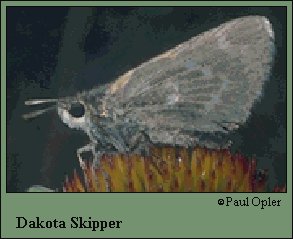 |
 

 |



Dakota Skipper (Hesperia dacotae [Skinner])
Wing span: 1 - 1 3/8 inches (2.5 - 3.5 cm).
Identification: Forewings are stubby. Upperside is golden-orange with blurry dark markings; stigma of male forewing has black felt inside it; forewing of female has a white transparent spot below the end of the cell. Underside of the hindwing is yellow-orange in the male, brown-gray in the female; both with or without a faint band of spots.
Life history: Adults have a low, fast flight. Mating occurs on the first day of emergence, with males perching on low vegetation to watch for receptive females. Eggs are laid singly on broad-leaved plants, and the caterpillars must climb down into the grasses. Caterpillars eat grass leaves at night and make shelters of silken tubes lined with grass. Fourth-stage caterpillars overwinter in shelters that are partially underground.
Flight: One brood from mid-June to early August.
Caterpillar hosts: Little bluestem (Andropogon scoparius), bluegrass (Poa pratensis), and panic grass (Panicum).
Adult food: Nectar from a variety of flowers including prairie coneflower, purple coneflower, blanket flower, fleabane, black-eyed susans, ox-eye daisy, and harebell.
Habitat: Rolling hills of native tall-grass prairie.
Range: Southern Manitoba and western North Dakota to western Minnesota, south to northwest Iowa.
Conservation: Conversion of tall-grass prairie to agricultural use has eliminated most of the habitat of the Dakota Skipper. All populations should be protected.
The Nature Conservancy Global Rank: G2 - Imperiled globally because of rarity (6 to 20 occurrences), or because of other factors demonstrably making it very vulnerable to extinction throughout its range. (Endangered throughout its range).
Management needs: Care should be taken not to extirpate populations through the use of fire as a management tool.
References:
Opler, P. A. and G. O. Krizek. 1984. Butterflies east of the Great Plains. Johns
Hopkins University Press, Baltimore. 294 pages, 54 color plates.
Opler, P. A. and V. Malikul. 1992. A field guide to eastern butterflies. Peterson
field guide #4. Houghton-Mifflin Co., Boston. 396 pages, 48 color plates.
Scott, J. A. 1986. The butterflies of North America. Stanford University Press,
Stanford, Calif. 583 pages, 64 color plates.
Stanford, R. E. and P. A. Opler. 1993. Atlas of western USA butterflies including
adjacent parts of Canada and Mexico. Denver and Fort Collins, CO.
Tilden, J. W. 1986. A field guide to western butterflies. Houghton-Mifflin Co.,
Boston, Mass. 370 pages, 23 color plates.
Author: Jane M. Struttmann
State and Regional References:
Opler, Paul A. 1999. Peterson Field Guide to Western Butterflies, revised
edition. Houghton Mifflin Co., Boston, Mass.
Stanford, R.E. and P.A. Opler. 1993. Atlas of Western USA Butterflies.
Privately published, Denver, Colo.
Tilden, J.W. and A.C. Smith. 1986. A Field Guide to Western Butterflies.
Houghton Mifflin Co., Boston, Mass.

